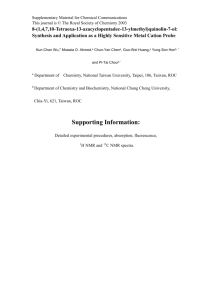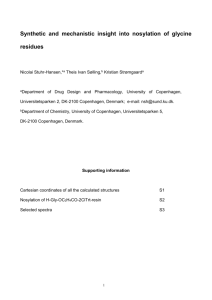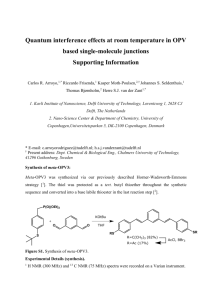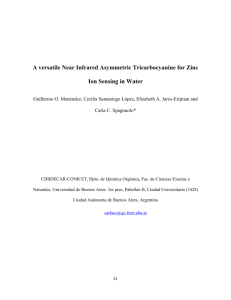A Novel Fluorescent Sensor for hydrophobic Amines in
advertisement
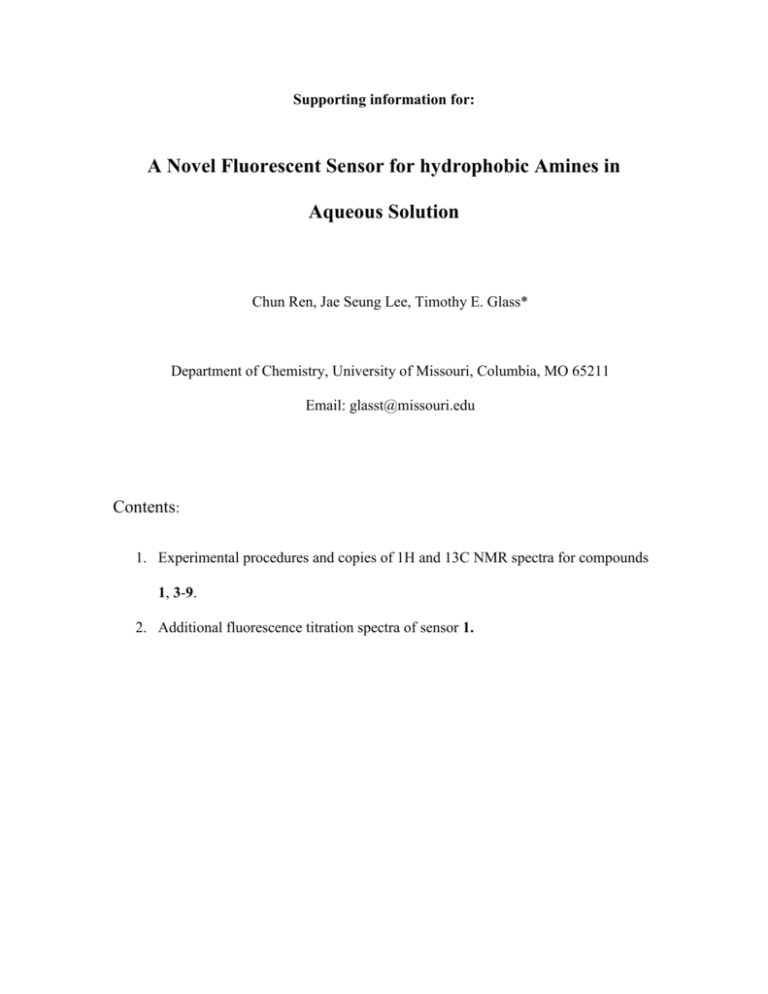
Supporting information for: A Novel Fluorescent Sensor for hydrophobic Amines in Aqueous Solution Chun Ren, Jae Seung Lee, Timothy E. Glass* Department of Chemistry, University of Missouri, Columbia, MO 65211 Email: glasst@missouri.edu Contents: 1. Experimental procedures and copies of 1H and 13C NMR spectra for compounds 1, 3-9. 2. Additional fluorescence titration spectra of sensor 1. 1. EXPERIMENTAL PROCEDURES General Fluorescence Titration Procedures. Fluorescence spectra were obtained on a Shimadzu RF-5301 PC Spectrofluorophotometer. Solutions of sensor (5x10-5 ~ 10-6 M) were prepared in buffer (20 mM HEPES, 100 mM NaCl, adjusted to pH = 7.0). This solution was placed in a cuvette (1 ml), then titrated with a solution of the hydrophobic amines (3~118 mM in 20 mM HEPES, pH = 7.0 with 5x10-5 ~ 10-6 M sensor). The fluorescence change and corresponding concentration of guest were recorded. This data was fitted to a single site binding isotherm using Graphpad Prism 3.03. General Synthetic Procedures. All reactions were performed in dried glassware under nitrogen atmosphere unless otherwise noted. Benzene, tetrahydrofuran, and toluene were distilled from sodium/benzophenone under nitrogen immediately before use. Dichloromethane (DCM) and triethylamine (TEA) were distilled from calcium hydride under nitrogen immediately before use. Flash column chromatography was carried out with 32-63 μm silica gels. NMR spectra were run with a Bruker ARX-250 MHz, DRX-300 MHz, or DRX-500 MHz in CDCl3, CD3OD, or d6DMSO using tetramethylsilane (TMS) as a reference. IR spectra were run with a Thermo Scientific Auxiliary Equipment Module (AEM) for Nicolet FT-IR spectrometers. Mass spectra were run with a Bruker Apex-Qe FTMS at the Old Dominion University in Norfolk, VA. Control compound 3: To a solution of naphthalene dimer (72 mg, 0.14 mmol) in THF (3 ml) and methanol (3 ml) was dropwise added NaOH solution (1 ml, 6.0 N). The mixture was vigorously stirred at room temperature for 16 hours, and then quenched with HCl solution (1.0 N, 10 ml) and extracted with DCM/MeOH three times. The organic layers were combined and dried over sodium sulfate. After the solvents were stripped, the concentrate was triturated with DCM two times (10 ml x 2) to obtain compound 3 as a light pink solid (53 mg, 83% yield). m.p.: >200 ˚C; 1H-NMR (500 MHz, d6-DMSO) δ: 13.02 (s, br, 2H), 8.67 (d, 2H, J = 9.0 Hz), 7.58 (d, 2H, J = 9.0 Hz), 7.26 (dd, 2H, J = 2.8, 9.0 Hz), 7.19 (d, 2H, J = 2.5 Hz), 7.11 (d, 2H, J = 9.0 Hz), 6.35 (s, 1H), 5.56 (s, 1H), 4.73 (s, 4H), 2.41 (s, 2H); 13C-NMR (125 MHz, CDCl3) δ: 170.6, 154.3, 148.8, 130.6, 127.5, 126.7, 125.5, 119.7, 119.0, 118.5, 108.8, 91.4, 65.0, 26.6, 22.1; IR (KBr, cm1 ): 1730, 1242; HRMS for M+Na calcd. For (C27H20O8)Na+ 495.1050, found 495.1043. Diformylnaphthalene dimer 4: A solution of naphthalene dimer (250 mg, 0.473 mmol) and dichloromethyl methyl ether (0.168 ml, 1.89 mmol) in DCM (40 ml) was chilled in ice bath for 15 minutes, followed by the dropwise addition of TiCl4 (1.89 ml, 1.0 M in DCM, 1.89 mmol). The mixture was kept at 0 °C for 1.5 hours, then slowly warmed up to room temperature and continued to stir 3 hours under nitrogen. The reaction was quenched with saturated NaHCO3 (100 ml) and extracted with DCM four times (30 ml x 4). The organic layers were combined, dried over anhydrous MgSO4, filtered and concentrated to get crude product (283 mg). The diformylnaphthalene dimer 4 was purified with flash silica column chromatography (3~4% Et2O/DCM) and a yellow solid (181 mg, 0.31 mmol, 66% yield) was isolated. m.p.: 172-173˚C; H-NMR (250 MHz, CDCl3) δ: 10.89 (s, 1H), 9.07 (d, 2H, J = 9.4 Hz), 8.65 (d, 2H, J = 9.5 Hz), 1 7.28 (d, 2H, J = 9.3 Hz), 7.21 (d, 2H, J = 9.5 Hz), 6.27 (s, 1H), 5.21 (s, 1H), 4.83 (s, 4H), 4.28 (q, 4H, J = 7.2 Hz), 2.43 (t, 2H, J = 2.5 Hz), 1.28 (t, 6H, J = 7.1 Hz); 13C-NMR (125 MHz, CDCl3) δ: 191.9, 168.1, 160.0, 149.5, 130.5, 127.6, 126.7, 125.5, 122.0, 118.4, 118.3, 113.5, 91.1, 66.5, 61.6, 26.6, 22.7, 14.0; IR (KBr, cm-1): 2974, 1759, 1671; HRMS for M+Na calcd. For (C33H28O10)Na+ 607.1574, found 607.1573. Bishydroxymethylnaphthalene dimer 5: To a solution of dialdehyde 4 (734 mg, 1.26 mmol) in THF (20 ml) and ethanol (20 ml) in ice bath was added NaBH4 (118 mg, 3.14 mmol). The reaction was kept at 0 °C for 30 minutes, and then quenched with hydrochloride acid (1.0 N) at 0 °C until no bubbles formed. The mixture was extracted with DCM three times (50ml x 3), dried over sodium sulfate, and evaporated to get crude product (759 mg). After purification with flash silica column chromatography (10% ~ 25% Et2O/DCM), the desired product 5 was isolated as a white solid (670 mg, 90% yield). m.p.: 144 - 155˚C; 1H-NMR (300 MHz, CDCl3) δ: 8.45 (d, 2H, J = 9.5 Hz), 7.95 (d, 2H, J = 9.0 Hz), 7.21 ~ 7.18 (m, 4H), 6.26 (s, 1H), 5.25 (s, 1H), 5.09 (q, 4H, J = 12.0 Hz), 4.77 (dd, 4H, J = 8.5, 16 Hz), 4.20 (q, 4H, J = 7.5 Hz), 2.41 (s, 2H), 1.25 (t, 6H, J = 7.5 Hz); 13C-NMR (125 MHz, CDCl3) δ: 170.1, 152.0, 149.4, 129.4, 127.9, 125.5, 124.6, 124.4, 120.0, 118.9, 115.2, 91.6, 67.4, 61.9, 55.8, 27.2, 23.2, 14.3; IR (KBr, cm-1): 3428, 2968, 1742, 1207, 1107; HRMS for M+Na calcd. For (C33H32O10)Na+ 611.1888, found 611.1882. Dibromide 6: To a solution of dialcohol 5 (670 mg, 1.14 mmol) in DCM (40 ml) was dropwise added PBr3 (271 ml, 2.85 mmol). The mixture was vigorously stirred at room temperature under nitrogen for 12 hours, and then quenched with icy NaHCO3. The mixture was extracted with DCM three times (70 ml x3), dried over sodium sulfate, and evaporated to dryness in vacuo to get product 6 as a gray solid (790 mg, 97% yield) which was used without further purification. m.p.: 174-176˚C; 1H-NMR (500 MHz, CDCl3) δ: 8.50 (d, 2H, J = 9.5 Hz), 7.86 (d, 2H, J = 9.5 Hz), 7.30 (d, 2H, J = 9.5 Hz), 7.19 (d, 2H, J = 9.0 Hz), 6.29 (s, 1H), 5.28 (s, 1H), 5.06 (dd, 4H, J = 10.0, 45.0 Hz), 4.81(s, 4H), 4.26 (q, 4H, J = 4.5 Hz), 2.44 (t, 2H, J = 2.5 Hz), 1.29 (t, 6H, J = 4.0 Hz); C-NMR (125 MHz, CDCl3) δ: 168.9, 151.9, 149.4, 128.5, 127.5, 125.1, 123.6, 121.1, 13 120.1, 118..9, 114.5, 91.3, 67.0, 61.5, 26.8, 24.7, 23.0, 14.2; IR (KBr, cm-1): 2974, 1754, 1599, 1201; HRMS for M+Na calcd. For (C33H30Br2O8)Na+ 735.0200, found 735.0196. Alkylated carbaozle 8: To a solution of 2-hydroxycarbazole (1 g, 5.3 mmol) in THF was added K2CO3 (0.84 g, 6.3 mmol), and ethyl bromoacetate (0.65 ml, 5.8 mmol). The reaction was vigorously stirred and refluxed under nitrogen for 16 hours, and then quenched with dilute hydrochloric acid (50 ml 1.0 N HCl + 50 ml water). The mixture was extracted with DCM three times (100 ml x3), dried over sodium sulfate, and evaporated to get crude product. The desired product 8 was obtained after purification with flash silica column chromatography (DCM) to get a gray solid (1.14 g, 80% yield). m.p.: 182-185˚C; 1H-NMR (300 MHz, CDCl3) δ: 7.99 ~ 7.93 (m, 3H), 7.38 ~ 7.32 (m, 2H), 7.24 ~ 7.19 (m, 1H), 6.97 (d, 1H, J = 2.1 Hz), 6.88 (dd, 1H, J = 2.4, 8.4 Hz), 4.72 (s, 2H), 4.29 (q, 2H, J = 7.1 Hz), 1.31 (t, 3H, J = 7.1 Hz); 13C-NMR (125 MHz, CDCl3) δ: 169.2, 157.2, 140.6, 139.6, 124.9, 123.3, 121.2, 119.7, 118.2, 110.4, 108.3, 96.3, 66.2, 61.4, 14.2; IR (KBr, cm-1): 3334, 1740, 1430, 1229, 1180; HRMS for M+Na calcd. For (C16H15NO3)Na+ 292.0944, found 292.0938. 8, tBuOK 8 Intermediate 9: To a solution of alkyloxycarbazole 8 (17 mg, 0.063 mmol) in DMF (3 ml) was added tBuOK (32 ul, 20% wt in THF, 0.053 mmol), followed by the addition of dibromide 6 (15 mg, 0.021 mmol). The mixture was stirred under nitrogen for 24 hours, and then quenched with hydrochloride acid (1.0 N, 1.0 ml) and evaporated to dryness under reduced pressure. The concentrate was separated between DCM and water, and extracted with DCM three times (25 ml x 3). The combined organic layers were dried over MgSO4, filtered, and concentrated to get crude (34 mg). The desired half tube tetraester 9 was isolated as a gray amorphous solid (21 mg, 0.019 mmol, 87% yield) after purification with flash silica column chromatography (DCM ~ 4% Et2O/DCM). m.p.: >200˚C; 1H-NMR (500 MHz, CDCl3) δ: 8.52 (d, 2H, J = 9.5 Hz), 7.92 (d, 2H, J = 7.7 Hz), 7.88 (d, 2H, J = 8.5 Hz), 7.64 (d, 2H, J = 9.3 Hz), 7.35 (d, 2H, J = 8.2 Hz), 7.28 ~ 7.22 (m, 4H), 7.12 (t, 2H, J = 7.4 Hz), 6.96 (d, 2H, J = 9.3 Hz), 6.87 (d, 2H, J = 1.9 Hz), 6.78 (dd, 2H, J = 2.1, 8.5 Hz), 6.36 (s, 1H), 5.62 (dd, 4H, J = 15.2, 86.2 Hz), 5.22 (s, 1H), 4.64 (s, 4H), 4.54 (s, 4H), 4.21 ~ 4.14 (m, 8H), 2.32 (s, 2H), 1.22 (t, 6H, J = 7.1 Hz), 1.17 (t, 6H, J = 7.1 Hz); C-NMR (125 MHz, CDCl3) δ: 169.1, 169.0, 157.0, 151.7, 149.0, 141.8, 141.0, 129.6, 127.4, 13 124.6, 123.4, 123.0, 120.8, 120.0, 119.5, 119.3, 119.0, 118.9, 117.7, 114.2, 109.4, 107.8, 95.1, 91.2, 66.8, 65.9, 61.4, 61.2, 38.7, 26.8, 23.0, 14.1, 14.1; IR (KBr, cm-1): 2978, 1752, 1601, 1458, 1201, 1180; HRMS for M+Na calcd. For (C65H58N2O14)Na+ 1113.3780, found 1113.3805. Sensor 1: To a solution of open tube tetraester in THF (6 ml) and methanol (8 ml) was dropwise added a solution of NaOH (2 ml, 6 N). The mixture was vigorously stirred at room temperature for 16 hours. After the solvents were stripped by nitrogen flow, dilute hydrochloric acid (5 ml, 1.6 N) was added to triturate the residue. A trituration with DCM may be needed if grease is appreciable. The tetracarboxylic acid 1 was isolated as a black solid (5 mg, 93% yield). m.p.: >200˚C; 1H-NMR (500 MHz, d6-DMSO) δ: 13.07 (s, br, 4H), 8.78 (d, 2H, J = 9.6 Hz), 7.96 (d, 4H, J = 8.6 Hz), 7.61 (d, 2H, J = 9.3 Hz), 7.53 ~ 7.50 (m, 4H), 7.24 (d, 2H, J = 1.7 Hz), 7.17 (t, 2H, J = 7.4 Hz), 7.07 (t, 2H, J = 7.4 Hz), 6.87 (d, 2H, J = 9.3 Hz), 6.77 (dd, 2H, J = 2.0, 8.5 Hz), 6.21 (s, 1H), 5.93 (dd, 4H, J = 15.3, 25.37 Hz), 5.55 (s, 1H), 4.96 (dd, 4H, J = 8.2, 16.5 Hz), 2.26 (s, 2H); 13C-NMR (125 MHz, d6-DMSO) δ: 170.8, 170.6, 157.4, 152.9, 148.5, 141.9, 140.7, 129.1, 127.2, 125.8, 124.7, 123.6, 122.8, 121.2, 119.9, 119.6, 119.3, 119.2, 118.4, 116.7, 114.9, 110.1, 108.0, 95.2, 91.1, 66.3, 65.1, 55.3, 38.5, 25.9, 22.1; IR (KBr, cm-1): 3423, 2918, 1728, 1598, 1462, 1180; HRMS for M+ calcd. For (C57H42N2O14)Na+ 1001.2528, found 1001.2520. 2. Fluorescence titration spectra 100 Binding isotherm 80 0.6 60 1-I/I0 0.4 40 0.2 20 0.0 0.000 0 376 426 476 0.001 0.002 0.003 Concentration (M) Figure S1 Fluorescence titration of compound 1 with octylamine in buffer (20 mM HEPES, 100 mM NaCl; pH = 7.0; [1] = 10-5 M; λex = 366 nm): a) Fluorescence emission spectra as a function of added octylamine, b) Fit of the titration data at em = 386 nm to a single-site binding isotherm. 600 Binding isotherm 500 0.8 400 0.6 1-I/I0 300 0.4 200 0.2 100 0.0 0.000 0 376 426 476 0.001 0.002 0.003 0.004 0.005 Concentration (M) Figure S2 Fluorescence titration of compound 1 with hexanediamine in buffer (20 mM HEPES, 100 mM NaCl; pH = 7.0; [1] = 10-5 M; λex = 366 nm): a) Fluorescence emission spectra as a function of added hexanediamine, b) Fit of the titration data at em = 386 nm to a single-site binding isotherm. 450 Binding isotherm 400 0.8 350 300 0.6 1-I/I0 250 200 150 0.4 0.2 100 50 0.0 0.000 0 376 426 476 0.001 0.002 0.003 0.004 0.005 Concentration (M) Figure S3 Fluorescence titration of compound 1 with octanediamine in buffer (20 mM HEPES, 100 mM NaCl; pH = 7.0; [1] = 10-5 M; λex = 366 nm): a) Fluorescence emission spectra as a function of added octanediamine, b) Fit of the titration data at em = 386 nm to a single-site binding isotherm. Binding isotherm 400 350 1.0 300 0.8 250 1-I/I0 200 150 100 0.6 0.4 0.2 50 0.0 0.0000 0 376 426 476 0.0002 0.0004 0.0006 0.0008 Concentration (M) Figure S4 Fluorescence titration of compound 1 with methylhexanamine in buffer (20 mM HEPES, 100 mM NaCl; pH = 7.0; [1] = 10-5 M; λex = 366 nm): a) Fluorescence emission spectra as a function of added methylhexanamine, b) Fit of the titration data at em = 386 nm to a single-site binding isotherm. 400 Binding isotherm 350 1.0 300 0.8 250 1-I/I0 200 150 100 0.6 0.4 0.2 50 0.0 0.0000 0 376 426 0.0002 476 0.0004 0.0006 0.0008 Concentration (M) Figure S5 Fluorescence titration of compound 1 with tuaminoheptane in buffer (20 mM HEPES, 100 mM NaCl; pH = 7.0; [1] = 10-5 M; λex = 366 nm): a) Fluorescence emission spectra as a function of added tuaminoheptane, b) Fit of the titration data at em = 386 nm to a single-site binding isotherm. 350 Binding isotherm 300 0.8 250 0.6 1-I/I0 200 150 100 0.4 0.2 50 0 -50 376 426 476 0.0 0.000 0.002 0.004 0.006 0.008 Concentration (M) Figure S6 Fluorescence titration of compound 1 with heptaminol in buffer (20 mM HEPES, 100 mM NaCl; pH = 7.0; [1] = 10-5 M; λex = 366 nm): a) Fluorescence emission spectra as a function of added heptaminol, b) Fit of the titration data at em = 386 nm to a single-site binding isotherm. 400 binding isotherm 350 0.8 300 0.6 1-I/I0 250 200 150 0.4 0.2 100 50 0.0 0.000 0 376 426 0.001 0.002 0.003 0.004 0.005 -1 476 Concentration (M ) Figure S7 Fluorescence titration of compound 1 with phenethylamine in buffer (20 mM HEPES, 100 mM NaCl; pH = 7.0; [1] = 10-5 M; λex = 366 nm): a) Fluorescence emission spectra as a function of added phenethylamine, b) Fit of the titration data at em = 386 nm to a single-site binding isotherm. 450 400 350 300 250 200 150 100 50 0 Binding Isotherm 0.8 1-I/I0 0.6 0.4 0.2 0.0 0.000 376 426 476 0.001 0.002 0.003 0.004 Concentration (M) Figure S8 Fluorescence titration of compound 1 with pseudoephedrine in buffer (20 mM HEPES, 100 mM NaCl; pH = 7.0; [1] = 10-5 M; λex = 366 nm): a) Fluorescence emission spectra as a function of added pseudoephedrine, b) Fit of the titration data at em = 386 nm to a single-site binding isotherm.
